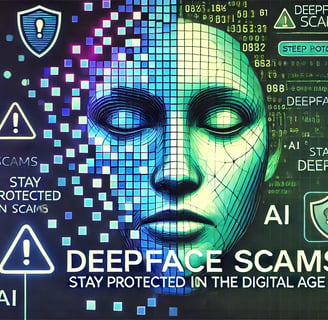Deep Face Scams: What They Are and How to Protect Yourself
Deepfake technology, powered by artificial intelligence, has opened up incredible possibilities for entertainment and innovation. However, it has also paved the way for dangerous scams, known as DeepFace scams, that are becoming alarmingly common. In this blog, we’ll explore how these scams work, real-life examples, and actionable steps you can take to protect yourself.


Deepfake technology has taken the world by storm, creating digital content that is almost indistinguishable from reality. But what exactly is a deepfake?
A deepfake is a piece of media—be it a video, audio clip, or image—manipulated using artificial intelligence (AI) to convincingly replace someone’s likeness or voice with another’s. While deepfakes have applications in entertainment and creativity, they are increasingly being weaponized for malicious purposes, giving rise to scams and frauds that exploit this powerful technology.
This blog dives into the darker side of deepfake technology—DeepFace scams—where these realistic manipulations are used to deceive, blackmail, and defraud individuals and organizations. We’ll explore real-life examples and offer actionable tips to help you protect yourself.
What Are DeepFace Scams?
DeepFace scams involve the use of AI to create hyper-realistic fake videos or images of individuals. Scammers manipulate these fakes to deceive, extort, or defraud unsuspecting victims. The technology behind deepfakes uses neural networks to map and replicate facial features, expressions, and even voices, making it nearly impossible to differentiate between fake and real content at first glance.
Why Are They Dangerous?
DeepFace scams exploit trust. Whether it’s impersonating a loved one, a trusted colleague, or a public figure, these scams manipulate people into making decisions they wouldn’t otherwise consider.
How to Detect and Prevent DeepFace Scams
Detecting DeepFace Content
Look for Inconsistencies
Pay attention to unnatural blinking, facial movements, or mismatched audio and lip sync. These are common signs of deepfake manipulation.
Metadata Analysis
Tools like InVID can help you verify the authenticity of videos by analyzing their metadata.
Reverse Image Search
Perform a reverse image search on suspicious photos using tools like Google Images to check if they are stolen or manipulated.
Preventing DeepFace Scams
Verify Requests
Always double-check unusual requests, especially those involving money or sensitive information. Use a trusted secondary communication method for confirmation.
Limit Your Digital Footprint
Be mindful of the personal photos and videos you share online. The less material available, the harder it is for scammers to create convincing deepfakes.
Leverage AI Detection Tools
AI tools like Deepware Scanner and Sensity AI are designed to detect deepfake content. Incorporate them into your cybersecurity toolkit.
Real-Life Cases of DeepFace Scams
Corporate Fraud
In a shocking case, scammers created a deepfake video of a CEO instructing employees to transfer large sums of money to a “company account.” Thinking the request was legitimate, the employees complied, resulting in losses worth millions.Online Blackmail
Cybercriminals use deepfake videos to fabricate compromising content involving their victims. They then threaten to release this fake content unless a ransom is paid.Romance Scams
On dating platforms, scammers use deepfake images and videos to create fake profiles. Once trust is established, they exploit their victims emotionally or financially.
Tools and Resources for Protection
Deepfake Detection Tools
Deepware Scanner: Scans media files to identify deepfake content.
Sensity AI: Offers enterprise-level solutions for detecting and managing deepfake threats.
Cybersecurity Awareness
Stay informed about emerging threats by following trusted cybersecurity resources and experts.
Reporting Scams
If you encounter a DeepFace scam, report it to your local authorities or cybersecurity agencies like CERT (Computer Emergency Response Team).
Final Thoughts
DeepFace scams are a growing threat, but with the right knowledge and tools, you can safeguard yourself and your loved ones. Stay vigilant, question suspicious content, and spread awareness about these scams to minimize their impact.
At thefridrick, we’re dedicated to keeping you informed and secure in the digital age. If you found this blog helpful, share it with others and check out our resources for cybersecurity tips. Together, we can outsmart scammers and protect our digital world!
Stay secure, stay informed.
